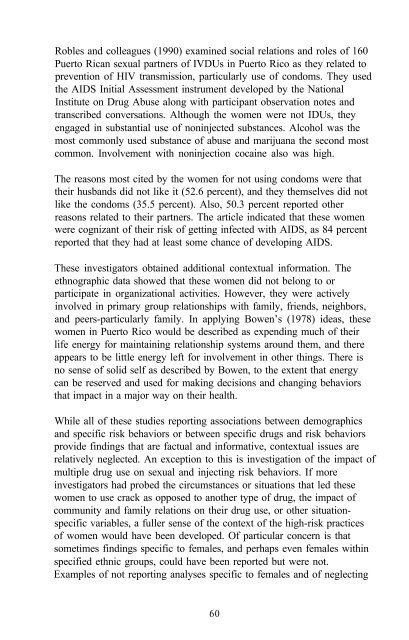The Context of HIV Risk Among Drug Users and Their Sexual Partners
The Context of HIV Risk Among Drug Users and Their Sexual Partners
The Context of HIV Risk Among Drug Users and Their Sexual Partners
You also want an ePaper? Increase the reach of your titles
YUMPU automatically turns print PDFs into web optimized ePapers that Google loves.
Robles <strong>and</strong> colleagues (1990) examined social relations <strong>and</strong> roles <strong>of</strong> 160<br />
Puerto Rican sexual partners <strong>of</strong> IVDUs in Puerto Rico as they related to<br />
prevention <strong>of</strong> <strong>HIV</strong> transmission, particularly use <strong>of</strong> condoms. <strong>The</strong>y used<br />
the AIDS Initial Assessment instrument developed by the National<br />
Institute on <strong>Drug</strong> Abuse along with participant observation notes <strong>and</strong><br />
transcribed conversations. Although the women were not IDUs, they<br />
engaged in substantial use <strong>of</strong> noninjected substances. Alcohol was the<br />
most commonly used substance <strong>of</strong> abuse <strong>and</strong> marijuana the second most<br />
common. Involvement with noninjection cocaine also was high.<br />
<strong>The</strong> reasons most cited by the women for not using condoms were that<br />
their husb<strong>and</strong>s did not like it (52.6 percent), <strong>and</strong> they themselves did not<br />
like the condoms (35.5 percent). Also, 50.3 percent reported other<br />
reasons related to their partners. <strong>The</strong> article indicated that these women<br />
were cognizant <strong>of</strong> their risk <strong>of</strong> getting infected with AIDS, as 84 percent<br />
reported that they had at least some chance <strong>of</strong> developing AIDS.<br />
<strong>The</strong>se investigators obtained additional contextual information. <strong>The</strong><br />
ethnographic data showed that these women did not belong to or<br />
participate in organizational activities. However, they were actively<br />
involved in primary group relationships with family, friends, neighbors,<br />
<strong>and</strong> peers-particularly family. In applying Bowen’s (1978) ideas, these<br />
women in Puerto Rico would be described as expending much <strong>of</strong> their<br />
life energy for maintaining relationship systems around them, <strong>and</strong> there<br />
appears to be little energy left for involvement in other things. <strong>The</strong>re is<br />
no sense <strong>of</strong> solid self as described by Bowen, to the extent that energy<br />
can be reserved <strong>and</strong> used for making decisions <strong>and</strong> changing behaviors<br />
that impact in a major way on their health.<br />
While all <strong>of</strong> these studies reporting associations between demographics<br />
<strong>and</strong> specific risk behaviors or between specific drugs <strong>and</strong> risk behaviors<br />
provide findings that are factual <strong>and</strong> informative, contextual issues are<br />
relatively neglected. An exception to this is investigation <strong>of</strong> the impact <strong>of</strong><br />
multiple drug use on sexual <strong>and</strong> injecting risk behaviors. If more<br />
investigators had probed the circumstances or situations that led these<br />
women to use crack as opposed to another type <strong>of</strong> drug, the impact <strong>of</strong><br />
community <strong>and</strong> family relations on their drug use, or other situationspecific<br />
variables, a fuller sense <strong>of</strong> the context <strong>of</strong> the high-risk practices<br />
<strong>of</strong> women would have been developed. Of particular concern is that<br />
sometimes findings specific to females, <strong>and</strong> perhaps even females within<br />
specified ethnic groups, could have been reported but were not.<br />
Examples <strong>of</strong> not reporting analyses specific to females <strong>and</strong> <strong>of</strong> neglecting<br />
60
















